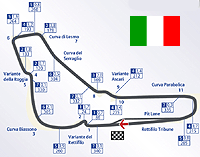 The Italian Grand Prix at Monza provides today's Formula One cars with perhaps the most severe test of the year. Nowhere is tougher on the engine or the brakes and the teams have to prepare a special package to cope with the unique challenge of Monza. And while it may look deceptively simple for the drivers, the circuit only gives away its secrets slowly, and the challenge of consistently finding the limit in low downforce configuration demands skill and finesse.
The Italian Grand Prix at Monza provides today's Formula One cars with perhaps the most severe test of the year. Nowhere is tougher on the engine or the brakes and the teams have to prepare a special package to cope with the unique challenge of Monza. And while it may look deceptively simple for the drivers, the circuit only gives away its secrets slowly, and the challenge of consistently finding the limit in low downforce configuration demands skill and finesse.
Aerodynamics
Monza is the fastest circuit on the calendar with an average speed of around 250 km/h and demands the development of a one-off aerodynamic package in order to attain competitive top speeds of around 340 km/h. This is often termed an "ultra low downforce" package, but the critical parameter is actually drag, and namely minimising its effects in order to achieve target top speeds. In the wind tunnel, the teams concentrate on ultra-efficient wing designs, which often vary quite significantly up and down the pit-lane. Naturally, these efficient low-drag wings also produce less downforce. The Monza aero package generates approximately 10% to 15% less downforce than the package used at the last race in Spa.
Suspension
Mechanical grip, stability and ride are major set-up parameters in Monza. This is firstly because the low downforce levels place a premium on mechanical grip, secondly because good braking stability is essential as the drivers spend nearly 15% of the lap on the brakes, and thirdly to ensure the drivers can use the kerbs aggressively in the chicanes in order to gain lap time. The set-up compromise must provide the drivers with a good change of direction in the low and medium-speed chicanes, while also ensuring strong traction exiting the slower corners. Equally, it is important to achieve good braking stability in order that the drivers can attack the heavy braking zones with confidence. The engineers will try and run the cars as low as possible for maximum aerodynamic performance. To avoid "touching" at high speeds, when the bottom of the car effectively drags along the ground, we use bump rubbers in the suspension and the car will 'sit' on these at high speed.
"The Ascari chicane is one of the most enjoyable parts of the lap," says Fernando Alonso. "You need to be aggressive under braking and then very smooth with the steering and throttle application through turns 9 and 10. The key to being quick is to take the straightest possible line, but it's not easy as the car always feels light with such low downforce and wants to oversteer on the exit of turn 8. As with all the chicanes in Monza, carrying good exit speed out of turn 10 is important so you don't come under pressure on the approach to Parabolica."
Brakes
The cars spend nearly 15% of the lap braking, meaning this is an area in which lap-time can be gained. The mechanical set-up will be tweaked to improve the driver's confidence in the car's braking stability, while the braking system itself is accorded special attention. The brakes are worked very hard at Monza, with the highest braking energies of the season, particularly into turn 1 where the drivers experience braking forces that peak at 4.5G. The cars must negotiate four big braking events from over 320 km/h, and special attention is paid to brake cooling to ensure optimum performance for minimal drag penalty.
"The biggest braking zone of the lap is turn one," reveals Alonso, "which is a very tricky corner as you have to slow the car from over 340 km/h to 60 km/h. It's easy to lock a wheel under braking and run wide which will cost you a lot of lap time. You also need to use the kerbs to straight-line the chicane as much as possible. It is possible to overtake here if you get a good slipstream down the main straight and dive down the inside."
Engine
Monza has always been known as the ultimate test of a Formula One engine. The engines spend 75% of the lap at full throttle, significantly above the season average of 62%. Furthermore, the engine must be capable of operating effectively over a 275 km/h range, from a maximum speed of around 340 km/h on the pit straight to the minimum speed of around 65 km/h in the first chicane. The longest time spent at full throttle is around 15.5 seconds, from the exit of the Parabolica to the braking point at the first chicane. The engine mapping must provide the drivers with good power delivery from low speed, and is also tuned for smooth high-speed response on the exit of corners such as Parabolica.
Reliability
In addition to the challenge of the heavy workload Monza imposes on the engine, the slow chicanes pose challenges for engine reliability. The drivers must use the kerbs aggressively to carry good speed through the corners, but there is a risk of excessive use of the rev limiter when the cars are in the air, and transmission damage when the spinning wheels land. Engine ancillaries must also be monitored to ensure they can withstand the severe demands of a lap at Monza.

 The Italian Grand Prix at
The Italian Grand Prix at 



















sign in